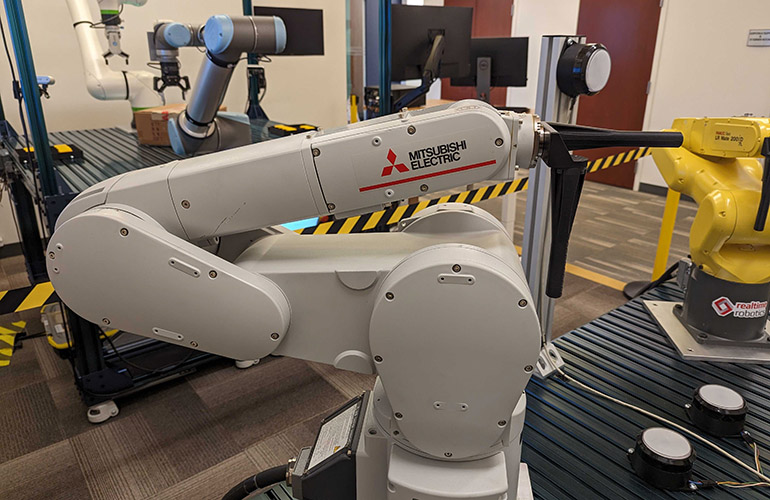|
Listen to this article |

Realtime is working with Mitsubishi Electric to develop its motion planning software. Source: Realtime Robotics
Manufacturing can benefit from increasingly intelligent robots as much as any other industry. Realtime Robotics today announced that it has secured a strategic investment from Mitsubishi Electric Corp., leading its recently opened Series B round. The company said it plans to use the funding to refine and scale its robot workcell and runtime systems, which will help engineers reduce costs and increase productivity.
“For years, industrial robot programming has remained a rigid, costly and labor-intensive process,” stated Peter Howard, CEO of Realtime Robotics. “Realtime is helping manufacturers realize the next wave of efficiency improvements necessary to get the most out of their new and existing automation applications.”
“Our optimization and runtime technologies constitute a powerful artificial intelligence that operates much like the human brain’s motor cortex, efficiently managing multiple actions at the same time,” he added. “Think of several cooks in a crowded kitchen being able to seamlessly work around each other to produce meals without error or collision. That’s the power of our technology.”
“We’re planning on using the funds to further scale and refine our optimization and runtime solutions,” Howard told The Robot Report.
Realtime Robotics refines motion control
Realtime Robotics said it is a leader in automatic, collision-free motion planning for industrial robots. In iterative design stages, the optimization software rapidly generates and evaluates hundreds of thousands of possible solutions.
“Our technologies reduce costs and improve productivity across the lifecycle of robotic workcells for both design engineers and manufacturers,” Howard explained. “For example, at the design stage, our optimization solution quickly finds the lowest cycle time on highly complex multi-robot cells with tight space such as spot welding for automotive framing.”
The Boston-based company claimed that its systems expand the potential of automation, empowering multiple robots to work closely together in collaborative workspaces. It added that runtime control further simplifies deployment and production, enabling multiple robots to work closer together, while simultaneously reacting to dynamic changes.
“In runtime, our auto-homing and dynamic obstacle avoidance unleashes the power of multiple robots in high-mix, low-volume or unstructured applications like machine tending, depalletizing, bin picking, and container unloading,” said Howard.
When the workcell needs to be retooled, the complex robot control can be reprogrammed for optimal cycle time from the first iteration, said Realtime Robotics. The company said its interfaces with leading simulation software brands and industry-standard controllers help customers and partners access its systems through their preferred methods.
Realtime’s customers include automotive manufacturers BMW and Volkswagen Commercial Vehicles, as well as integrators Valiant TMS and Schaeffler Group. They have reported improved cycle times, reduced downtime, and increased throughput as a result of working with Realtime.
Mitsubishi Electric expects efficiencies from automation
Mitsubishi Electric, which also participated in Realtime Robotics’ Series A round, will be adding a senior representative to Realtime’s board of directors. The Tokyo-based company said that it plans to “further integrate integrate Realtime’s motion-planning technology into 3D simulators and other software to optimize manufacturing through the power of digital twins.”
Later, Mitsubishi Electric said it expects to incorporate Realtime’s technology into factory automation (FA) control system devices, such as programmable logic controllers (PLCs), servo motors, and computer numerical controllers (CNCs). The manufacturer said it expects to eliminate production interruptions by expanding automation capabilities, streamlining plant operations for improved efficiency, and quickly responding to unexpected events.
“We’re excited to continue working directly with Mitsubishi on ways that they can utilize our technology throughout various aspects of their operations,” said Howard. “This will further enable their transformation into a circular digital-engineering company.”
Mitsubishi Electric said it has more than 100 years of experience in manufacturing and selling electrical and electronic equipment for factory automation, information processing and communications, space development and satellite communications, consumer electronics, energy, transportation, and building equipment. The company recorded a revenue of 5,257.9 billion yen ($34.8 billion U.S.) in the fiscal year ended March 31, 2024.
 Submit your presentation idea now.
Submit your presentation idea now.
Realtime fundraising, AI development continue
While the companies didn’t specify the amount of the investment, Realtime Robotics said Mitsubishi Electric’s expertise will help guide its development of automation for manufacturing.
“Mitsubishi has been a valued partner since our Series A was first announced, and we’ve worked closely with them on various projects,” said Howard. “Our technology has of course benefited from what we’ve learned as a part of this partnership — and we’re really excited to take this further.”
Realtime Robotics is also communicating with other investors, which Howard said he hopes to announce in the coming months. Ongoing improvements in artificial intelligence will also help robot control, he said.
“One thing I’ve learned from years in this industry is that there’s always room for improvement,” said Howard. “As simulation improves and AI matures, there will be an opportunity to become even more efficient in the ways a manufacturer’s process is analyzed and optimized.”
“Digital twins will become more exact, and AI can make better decisions faster than humans, as long as the data remains accurate,” he said. “Right now, there are a great deal of ways our programming and optimization solutions can advance the industry, but we’re keeping our eyes on how to make them even stronger as technology advances.”
